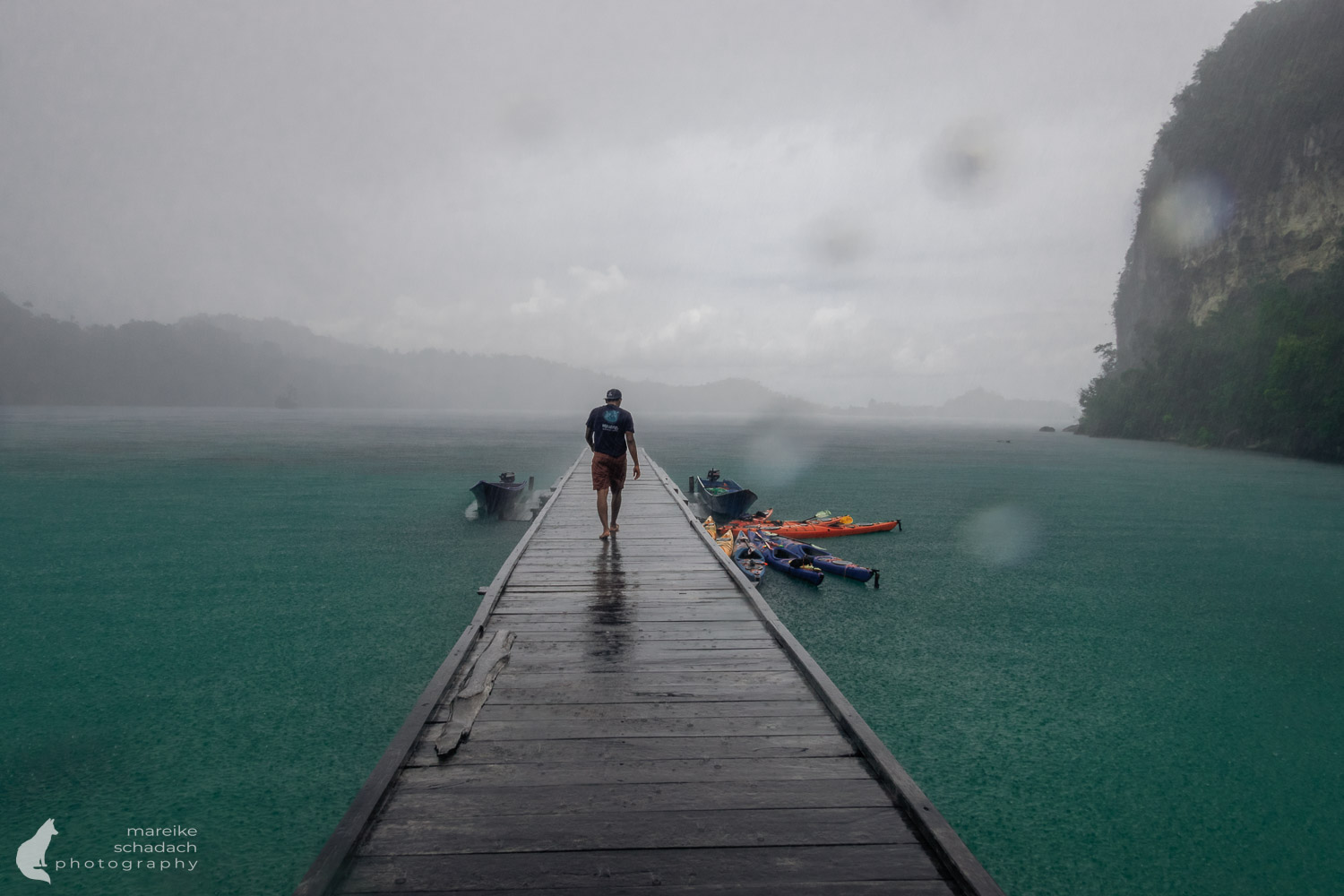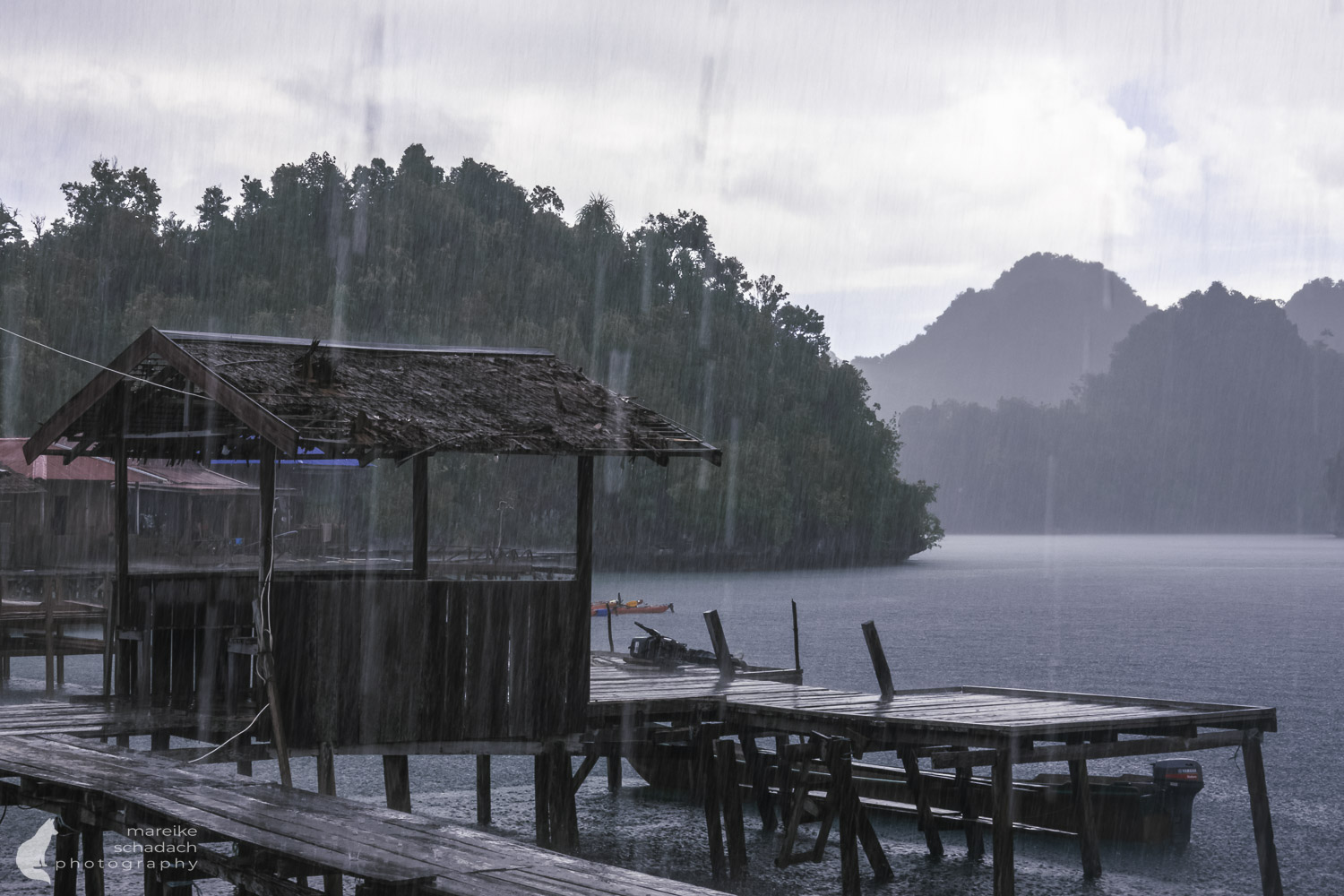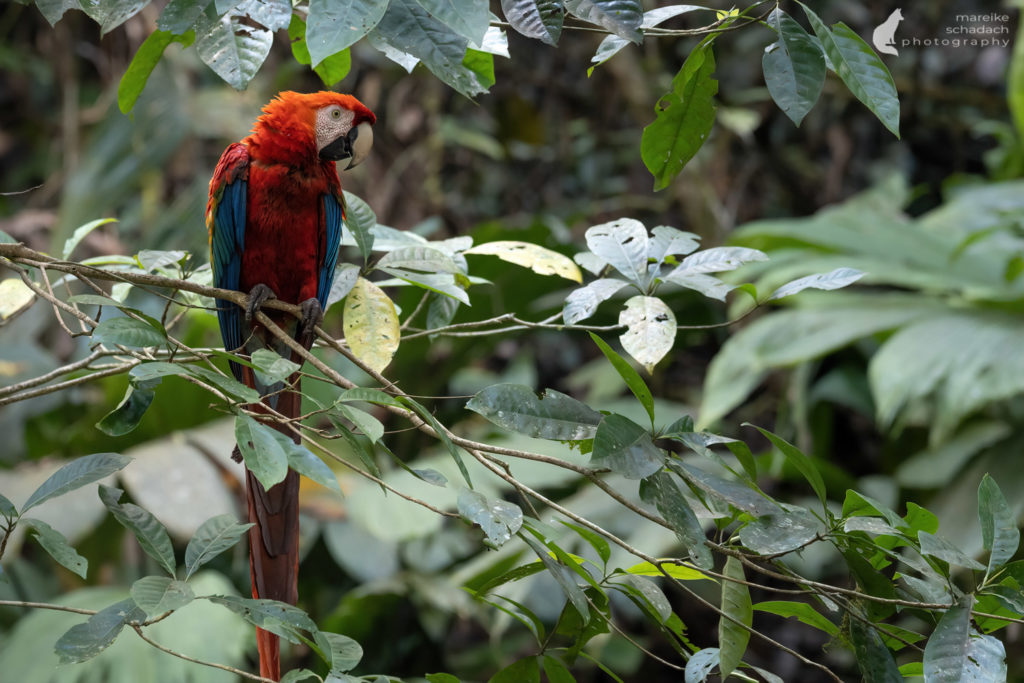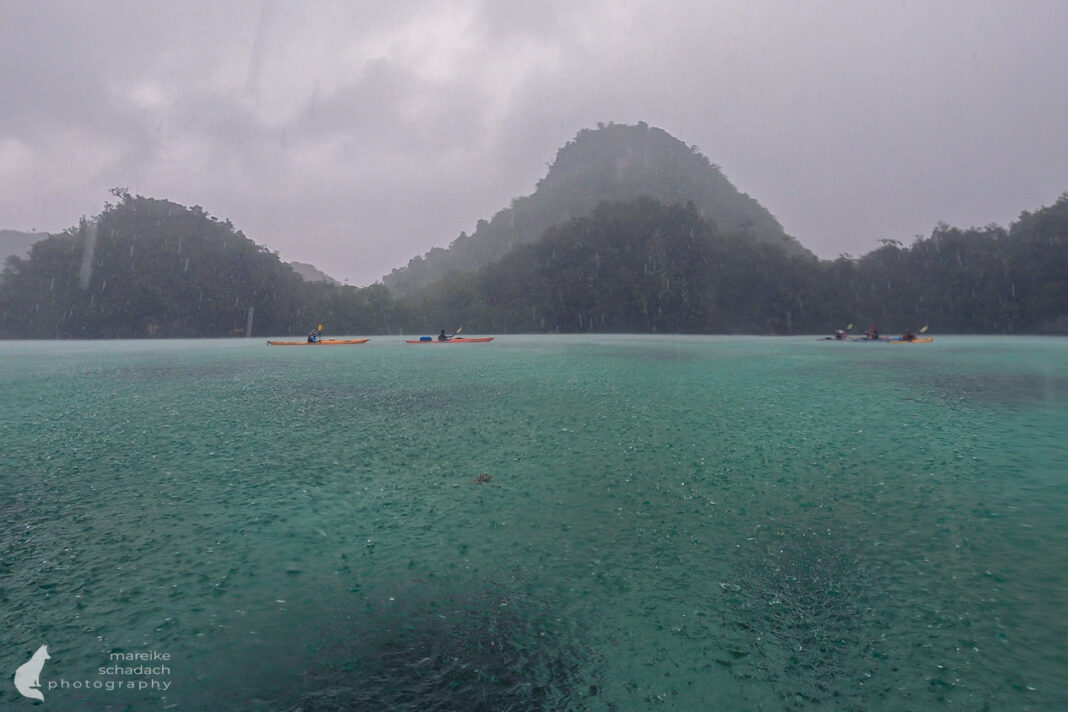Taking photos while traveling can sometimes be a challenge. The hand luggage on the plane weighs almost as much as the checked luggage. On trekking tours, there are quickly a few kilos too many in the rucksack, and the weather protection for the equipment becomes an essential component depending on the destination. If it were just rain and snow, but what can you do when it's not just raining cats and mice, but when the humidity is so high during photography that nothing dries out and when salt water is omnipresent?
Unassigned, unpaid advertising. The article contains affiliate links.
Experiences photographing during a Kayak Tour in Indonesia
I went on a 10-day sea kayaking tour in Indonesia at the turn of the year 2024/25. Our small group was traveling in the beautiful island archipelago of Misool, where we first paddled from island to island and later also in the jungle. Our accommodation was stilt huts over the water or tents on the beach, or in the jungle. It was around 30°C, it rained cats and dogs every afternoon, and our hands were always wet and swollen from the salt or rainwater. If they weren't wet, they were sticky from sun cream, insect repellent, and sweat. Once they were soaked, they hardly dried at all. The humidity reached its peak in the jungle, where it hung in the air in the form of misty clouds. Especially in the dark, you could see the fine droplets in the light of the flashlight.
I had my Sony Alpha with two lenses with me as well as a small compact Sony RX100 and a waterproof GoPro. You can find out how I protected my photo equipment from the humidity during the kayak tour in this article. I'll also give you practical tips on how to capture your tropical motifs in the changing light conditions.

What happens to the Camera in high Humidity?
You may be familiar with the situation where your lens fogs up when you take a photo in the snow and then go out into the warm. In this case, the camera is colder than the dew point of the water in the warm interior. As a result, the humidity in the warm air will condense on the cold camera after the photo has been taken. If you now step out of a cool, air-conditioned room into the humid, warm jungle, exactly the same thing happens, only the other way round. The camera fogs up until it has adapted to the warm ambient temperature. By then, however, a lot of moisture has already accumulated inside the equipment.
To avoid this, it is best to pack the camera in a Ziploc bag and wait until it has reached the ambient temperature. Then fogging due to humidity is no longer a problem, and you don't have to wait to take pictures.
On the other hand, if a camera has already accumulated moisture, then longer storage in an air-conditioned room is advantageous. The air conditioning dries the air as it cools, allowing moisture to escape from the camera.

Here's how to do it: Avoid Condensation on the Camera and Lens
- Get the camera used to the temperature: After entering the jungle, leave the camera switched off in the bag so that it slowly adapts to the outside air.
- Don't switch between air conditioning and outside : Avoid abrupt temperature changes.
- Drying : After the tour, leave the camera and lenses to dry in a well-ventilated room / in the sun.
Protecting the Camera Equipment in high Humidity and Rain
If the camera gets a few raindrops under normal conditions, it's no big deal. The drops will dry quickly. However, if this happens when photographing in the jungle in high humidity, the moisture remains on the camera and penetrates further and further. Under these tour conditions, it is then difficult to dry the already damp camera. However, if the moisture accumulated inside the equipment evaporates, the camera may fog up for a long time. This internal moisture is also a breeding ground for mold.
When photographing in high humidity in the jungle, it is therefore particularly important not to get the camera wet in the first place. Leave the camera packed in the bag for as long as possible and avoid changing the lenses. Also, be careful when replacing the battery.
I often have the following items with me on my photo tours and can highly recommend them for use in the jungle or at home in the rain or on a paddling tour with a camera. If you buy a product via one of these affiliate links from Amazon, I will receive a small commission, and you will help me to keep Fernweh-Motive running. It will not be more expensive for you.
This is how it works: Protect your Equipment from Rain
- Waterproof camera bags : Use a waterproof camera bag or case.
- Ziplock bags and drybags : Pack the camera and interchangeable lenses in Ziploc bags or dry bags. This will keep your equipment dry when you are not using it. Moisture that has already penetrated the camera equipment can be absorbed by the desiccant. This storage method is just as suitable on tour as it is after the tour.
- Silica gel : Silica gel packets in the camera bag help to reduce moisture. There is silica gel that changes color when saturated with moisture. As soon as a packet is saturated, it must be replaced or regenerated by heating it in the oven or microwave (follow the manufacturer's instructions). It is best to take spare packs with you on your trip if you do not have secure access to an oven or microwave.
- Rain cover : Pack a rain cover for the camera to protect it from sudden showers. A plastic bag held in place with an elastic band or braid will do if necessary. Leave the cover on even after the rain has passed, as water will still drip from the trees later.
- Protective filter : A UV filter protects the lens from moisture and scratches.
- Rain poncho: a poncho, which can be worn over the rucksack, provides additional protection against moisture. It can be quickly thrown on in the event of a sudden downpour and also protects the camera hanging around your neck.
- A towel: have a microfiber towel to hand to dry the camera immediately
Better safe than sorry: Rain as we know it from home is nothing compared to a tropical downpour. You're lucky if you can take shelter for the duration of the rain. If you have packed the camera in the rucksack in Ziploc bags, wear the rain cover over the rucksack, and also throw a poncho over yourself and the camera rucksack, your equipment is well protected.
Lens Fungus and Mold
Frequent fogging leads to water accumulation in photographic equipment. In the long term, this can lead to mold and fungus. This forms a white film on the glass, and the photos taken appear washed out. With a lens hood, the lens reflections increase. Removing the fungus and mold is usually difficult and expensive.


Rice as a Desiccant
The camera is damp, but you don't have any silica gel bags available? Then you can fall back on a tried and tested household remedy: rice. Fill a bag with normal, uncooked household rice and place the camera inside. For this to work, however, the camera must be completely covered in rice.
This is how it works: Camera Care after the Tour
- Cleaning : Wipe the camera and lenses thoroughly with a soft cloth after the tour. If the equipment has also been exposed to salt water, wipe it off with a slightly damp cloth beforehand.
- Moisture control : Store the camera in a dry bag or ziploc bag with fresh silica gel packets.
- Regenerating silica gel packets : Check whether the silica gel packets are already saturated with moisture and regenerate them in the microwave or oven if necessary.
Extreme Conditions and Safety for Photographers in the Jungle
Tropical heat and high humidity can also be challenging for photographers themselves. Drink plenty of water to stay hydrated. A sun hat and sunscreen are important to protect yourself from the strong UV rays. Mosquitoes and other insects are common in the tropics, so protect yourself with insect repellent. Did you think about the recommended vaccinations before your trip?

Photo Tips for the Jungle
- The tropical sun is often very strong during the day, and the light is harsh. Take photos in the early morning or late evening twilight to take advantage of soft, warm light and less harsh shadows.
- In the dense rainforest, the light is often diffuse. A higher ISO value and a larger aperture (small f-number) help to achieve clearly focused photos despite the lack of light.
- Detailed and close-up shots of leaves, moss, insects and dewdrops look particularly vivid.
- Use continuous shooting mode for animal photos and be patient. Animals are often difficult to see in the jungle and move quickly through the undergrowth.
- Photograph the rays of light that break through the canopy of leaves for atmospheric images with plays of light.
- Structure your jungle shots: There is often visual clutter in the rainforest. Pay attention to lines or natural frames such as tree trunks and leaves to direct the viewer's gaze.
- Tropical landscapes offer bright colors that are accentuated by strong contrasts. Use these contrasts deliberately to create points of attention in the picture.
- Wipe the lens regularly with a microfiber cloth.
- Use manual focus if necessary, as fog and moisture can affect the autofocus.
Conclusion
The tropics offer an incomparable variety of subjects - from exotic animals to lush vegetation and breathtaking landscapes. However, photographing in the jungle in high humidity requires special preparation, precautions, and techniques. With these tips and the right preparation, you can keep your camera in good shape, avoid humidity-related technical problems, and get the shots you want in tropical regions.

Book Recommendations for Photographers
Do you want to know more about photography and are you curious for inspiration? Then I can recommend these books*.
You can order the books with a click on the pictures on Amazon. If you buy a product via an affiliate link, I get a small commission, and you help me to keep filling Fernweh-Motive with interesting articles. The product will not be more expensive for you, and you will do me a huge favor.
Do you want to know when there are new articles on my blog? Then follow me on Facebook, Pinterest or Instagram. I would also be very happy if you share my article with your friends.
Recommendations for further Reading
Did you get a taste for it and want to delve deeper into the jungle? Then you might also be interested in my article Amazon of Ecuador: Travelogue and Tips around the Rio Napo and my article Muro de las Lagrimas - Guide for a Bike Tour on Isla Isabela.








